Canine Chiari Group at The University of Surrey
November 2022 Update
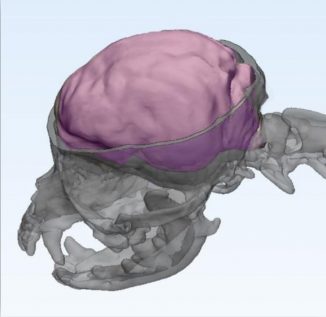 Background: Brachycephaly is associated with many health and welfare problems. One of the most serious is Chiari like malformation (CM). CM is characterised by a short skull resulting in brain and upper spinal cord overcrowding causing pain and leading to spinal cord cavities called syringomyelia (SM). It is common – one UK referral practice found that 9.7% of all dogs presented with neck pain had CM (CM-P) or SM.(1) SM can result in neurological problems include debilitating “phantom” scratching, scoliosis and weakness.
Background: Brachycephaly is associated with many health and welfare problems. One of the most serious is Chiari like malformation (CM). CM is characterised by a short skull resulting in brain and upper spinal cord overcrowding causing pain and leading to spinal cord cavities called syringomyelia (SM). It is common – one UK referral practice found that 9.7% of all dogs presented with neck pain had CM (CM-P) or SM.(1) SM can result in neurological problems include debilitating “phantom” scratching, scoliosis and weakness.
Currently SM is diagnosed by MRI whereas a diagnosis of CM-P is made by a combination of appropriate history and clinical signs, exclusion of other causes of pain and MRI. In some breeds, for example Cavalier King Charles spaniels (CKCS) and Chihuahua, CM is so common that it is very challenging to find an unaffected dog.
We know that certain head shapes make CM-P and SM more likely – dogs with a higher cephalic index1 with a prominent stop and reduced muzzle appear more at risk (2-4). This means breeders could select for a less risky head shape if they knew what to select for.
Who is the Head Space Project?
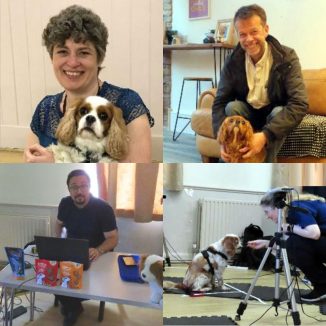
Professor Clare Rusbridge is a veterinary neurologist who has spent over 25 years researching Canine Chiari malformation and syringomyelia.
Dr Kevin Wells is a Reader in Medical Imaging and an expert in state-of-the-art computer vision technology and machine learning.
Dr Mehran Taghipour Gorjikolaie is employed full time on this project. Research Fellow Mehran is credited with building the system, writing the code, and solving the problems. He is an expert in application of Artificial Intelligence and Machine Learning techniques
Dr Emma Scales-Theobald is a Research Fellow with vHive at University of Surrey, spending most of her time researching Health Related Quality of Life (HRQoL) in canine and feline osteoarthritis and other canine osteoarthritis research. However, she very kindly donates personal time and expertise to the Canine Chiari Group. Emma (above) can be seen encouraging a CKCS to sit for the Head Space photograph
Aims of the Head Space Project
 In the Head Space Project, we aim to create an objective assessment of head shape using facial recognition technology to better define the face of CM-P and SM. To achieve this, we first built a dedicated 5-camera system which can gather 3D data to generate a 3D model of the complete head.
In the Head Space Project, we aim to create an objective assessment of head shape using facial recognition technology to better define the face of CM-P and SM. To achieve this, we first built a dedicated 5-camera system which can gather 3D data to generate a 3D model of the complete head.
We are now making 3D computer models of dogs with known clinical and MRI CM-SM status. We are comparing 3 groups of CKCS: 1) clinically normal CKCS – so called Chiari malformation – normal (CM-N) 2) CKCS with clinical signs from syringomyelia – so called syringomyelia – severe / signs (SM-S) 3) CKCS with clinical signs of pain and no syringomyelia – so called Chiari malformation pain (CM-P)
Progress so far
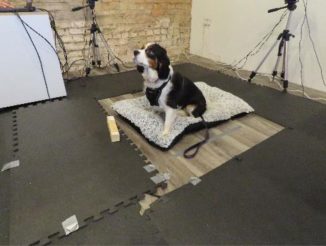
Development of the system – thanks to the skills of Mehran the five-3D camera system was developed and modified so that it could successfully capture the entire head in less than a second. This was an important development because even when a dog sits on command, they often move their head.
Pilot studies with University of Surrey teaching dogs – The University of Surrey teaching dogs are pets owned by staff and students and several of them participated (in return for treats!) in the pilot study. Following this Mehran rewrote and adapted computer code to improve the system.
Imaging of CKCS at the Companion Cavalier Group AGM – The Canine Chiari Group were delighted to be invited to this event and following a lecture by Clare, all the 21 CKCS at the event in May were successfully imaged.
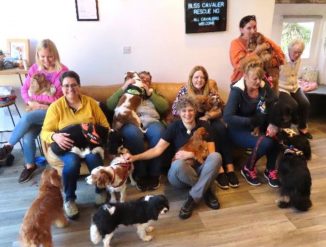
Imaging of CKCS at Bliss Cavalier Rescue – Sadly, many CKCS entering rescue are affected by CM-P and SM and consequently many have had neurological assessment and MRI and (thanks to Cavalier Matters Charity) in many cases CT. Thanks to the hard work of Becky Mosely and other volunteers at Bliss Cavalier rescue – the Canine Chiari group were able to image 24 dogs that attended this event in October. These dogs also had a respiratory function grading to contribute to the BOAS research under Dr Jane Ladlow at Cambridge university.
How does this tie in with other research projects?
The Canine Chiari group has several simultaneous and complementary projects, some are described below.
Improving screening for CM-P and SM using MRI and CT.
Breeders are advised to screen dogs for SM status prior to breeding but there is no robust system for categorising CM and risk of CM-P. Better characterisation of a healthy versus unhealthy skull shape is urgently required so that vigorous and economic screening schemes are possible.
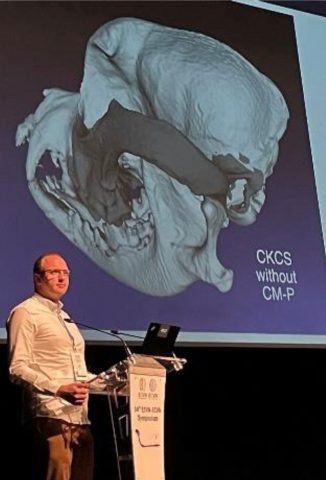
Jake Cumber’s doctoral project uses a machine learning technique to grade MRI scans for SM and CM-P using artificial intelligence. His research won the best neuroimaging presentation at the 2022 European College of Veterinary Neurology Annual Symposium (right)
The current BVA CM/SM health scheme relies on a single, small field of view, one-dimensional MRI and therefore cannot represent 3D morphological changes of the skull and cervical vertebrae. Compared to MRI, CT is a significantly lower cost screening technique with full 3D data. In the future Jake hopes to develop his novel machine learning based on spherical harmonics to CT and 3D MRI in CKCS and Chihuahua in the anticipation that this could be a useful and more economic screening test for breeders.
Development of a CM-P Diagnostic tool (App with algorithm that generates a CM-pain score)
In association with Dr Mariam Cirovic of the University of Surrey Computer science department, this project is developing customised software that will triage the likelihood of CM-P and inform the owner and vet the likelihood of CM-P before recommendation for expensive diagnostic tests. Ultimately, we aim to combine this diagnostic tool to a generic and validated HRQL to create a CM-P specific HRQoL tool.
Dogs participating in the Head Space project are also helping with this project by validating the questionnaire.
Collaboration with the Cambridge BOAS Research Group
The Cambridge BOAS group are investigating whether and how BOAS affects 13 different brachycephalic dog breeds including CKCS, King Charles spaniels and Chihuahua. In October Clare Rusbridge and Emma Scales-Theobald attended a training course by Jane Ladlow and the UK Kennel Club to become Regional Approved Assessors for the KC/UoC Respiratory Function Grading Scheme. This is with the intention that we can contribute to the Cambridge project and vice versa.
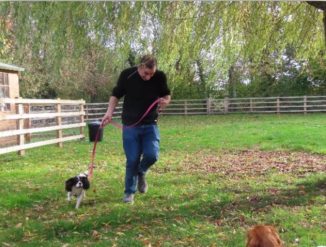
During a respiratory grading we listen to the breathing sounds before and after a 3-minute run.
In the future we hope to translate the Machine Learning Techniques we are using for the CT and Head Shape project to other diseases such as BOAS.
How can CKCS and Chihuahua owners get involved with the Head Space project?
Soon we will be having Head Space imaging days at the University of Surrey and also hope to attend other UK Dog Meets. If you have a dog with known CMSM MRI status and you are interested in participating at one of these events, then please contact Clare Rusbridge: C.Rusbridge@nullsurrey.ac.uk
When the CM-Pain Score tool is validated, we will also be Head Space imaging dogs with a known CM-pain score.
Who has been funding this research?
- A Dogs Trust Canine Welfare grant is the major funder for the Head Space Project (funding until Sept 2023; funding beyond that is being sought)
- The Advisory Council on the Welfare Issues of Dog Breeding Charitable Trust provided funds to buy the 3D cameras and associated hardware
- The Hannah Hasty Memorial Fund enabled the Head Space team field trip to Bliss Cavaliers; Clare Rusbridge and Emma Scales-Theobald to become BOAS Regional Approved Assessors; and the purchase of the fifth 3D camera
- Cavalier Matters charity paid for over 40 CKCS to have CT in addition to their diagnostic MRI
- The CM-Pain Score Tool has initial funding from CavalierHealth.org and its Cavalier Health Fund charitable trust
Definitions
- Brachycephaly – short cranial cavity i.e., the part of the skull containing the brain. Many brachycephalic dogs are also flat faced
- Cephalic Index – To calculate the cephalic index – measure the skull at its widest point, then multiply that by 100 and divide the result by the maximum length of the skull. Brachycephalic dogs have a high cephalic index with a broad short skull
- BOAS – Brachycephalic obstructive airway disease – breathing difficulties related to being brachycephalic and flat faced.
- CM-P – Chiari – malformation associated pain
- CM-N – Dogs with a degree of Chiari malformation on MRI but with no signs of pain or other neurologicaldysfunction. Chiari malformation is ubiquitous in some breeds like CKCS
- SM – Syringomyelia
- SM-S – where there are clinical signs from syringomyelia (syringomyelia – severe / signs)
- HRQoL – Health-related quality of life
References
- De Strobel F, Paluš V, Vettorato E, Cherubini GB. Cervical hyperaesthesia in dogs: an epidemiological retrospective study of 185 cases. Journal of Small Animal Practice. 2019;60(7):404-10
- Knowler SP, Dumas E, Spiteri M, McFadyen AK, Stringer F, Wells K, et al. Facial changes related to brachycephaly in Cavalier King Charles Spaniels with Chiari-like malformation associated pain and secondary syringomyelia. Journal of Veterinary Internal Medicine. 2020;34(1):237-46
- Knowler SP, Gillstedt L, Mitchell TJ, Jovanovik J, Volk HA, Rusbridge C. Pilot study of head conformation changes over time in the Cavalier King Charles spaniel breed. The Veterinary record. 2019;184(4):122
- Mitchell TJ, Knowler SP, van den Berg H, Sykes J, Rusbridge C. Syringomyelia: determining risk and protective factors in the conformation of the Cavalier King Charles Spaniel dog. Canine Genet Epidemiol. 2014;1:9
- Spiteri M, Knowler SP, Rusbridge C, Wells K. Using machine learning to understand neuromorphological
change and image-based biomarker identification in Cavalier King Charles Spaniels with Chiari-like malformation- associated pain and syringomyelia. Journal of Veterinary Internal Medicine. 2019;0(0) - Knowler SP, Spiteri M, McFadyen AK, Stringer F, K. W, C. R, editors. Morphometric Analysis of Brachycephalic Features Identified by Machine Learning Technique in Dogs with/without Syringomyelia. ACVIM Speciality Symposium 2018; Seattle: ACVIM Forum

